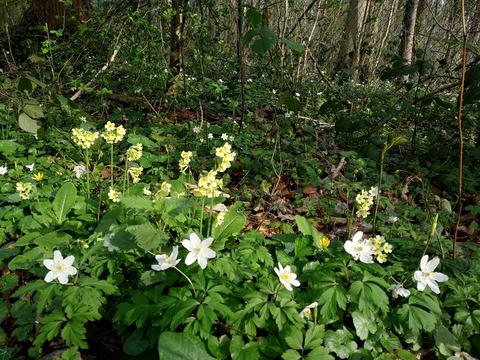Our official English website, www.x-mol.net, welcomes your feedback! (Note: you will need to create a separate account there.)
Taxonomic, phylogenetic and functional diversity of understorey plants respond differently to environmental conditions in European forest edges
Journal of Ecology ( IF 5.5 ) Pub Date : 2021-04-16 , DOI: 10.1111/1365-2745.13671 Karen De Pauw 1 , Camille Meeussen 1 , Sanne Govaert 1 , Pieter Sanczuk 1 , Thomas Vanneste 1 , Markus Bernhardt‐Römermann 2 , Kurt Bollmann 3 , Jörg Brunet 4 , Kim Calders 5 , Sara A. O. Cousins 6 , Martin Diekmann 7 , Per‐Ola Hedwall 4 , Giovanni Iacopetti 8 , Jonathan Lenoir 9 , Sigrid Lindmo 10 , Anna Orczewska 11 , Quentin Ponette 12 , Jan Plue 6, 13 , Federico Selvi 8 , Fabien Spicher 9 , Hans Verbeeck 5 , Pieter Vermeir 14 , Florian Zellweger 3 , Kris Verheyen 1 , Pieter Vangansbeke 1 , Pieter De Frenne 1
中文翻译:

下层植物的分类、系统发育和功能多样性对欧洲森林边缘环境条件的反应不同
更新日期:2021-04-16
Journal of Ecology ( IF 5.5 ) Pub Date : 2021-04-16 , DOI: 10.1111/1365-2745.13671 Karen De Pauw 1 , Camille Meeussen 1 , Sanne Govaert 1 , Pieter Sanczuk 1 , Thomas Vanneste 1 , Markus Bernhardt‐Römermann 2 , Kurt Bollmann 3 , Jörg Brunet 4 , Kim Calders 5 , Sara A. O. Cousins 6 , Martin Diekmann 7 , Per‐Ola Hedwall 4 , Giovanni Iacopetti 8 , Jonathan Lenoir 9 , Sigrid Lindmo 10 , Anna Orczewska 11 , Quentin Ponette 12 , Jan Plue 6, 13 , Federico Selvi 8 , Fabien Spicher 9 , Hans Verbeeck 5 , Pieter Vermeir 14 , Florian Zellweger 3 , Kris Verheyen 1 , Pieter Vangansbeke 1 , Pieter De Frenne 1
Affiliation

|
- Forest biodiversity world-wide is affected by climate change, habitat loss and fragmentation, and today 20% of the forest area is located within 100 m of a forest edge. Still, forest edges harbour a substantial amount of terrestrial biodiversity, especially in the understorey. The functional and phylogenetic diversity of forest edges have never been studied simultaneously at a continental scale, in spite of their importance for the forests' functioning and for communities' resilience to future change.
- We assessed nine metrics of taxonomic, phylogenetic and functional diversity of understorey plant communities in 225 plots spread along edge-to-interior gradients in deciduous forests across Europe. We then derived the relative effects and importance of edaphic, stand and landscape conditions on the diversity metrics.
- Here, we show that taxonomic, phylogenetic and functional diversity metrics respond differently to environmental conditions. We report an increase in functional diversity in plots with stronger microclimatic buffering, in spite of their lower taxonomic species richness. Additionally, we found increased taxonomic species richness at the forest edge, but in forests with intermediate and high openness, these communities had decreased phylogenetic diversity.
- Functional and phylogenetic diversity revealed complementary and important insights in community assembly mechanisms. Several environmental filters were identified as potential drivers of the patterns, such as a colder macroclimate and less buffered microclimate for functional diversity. For phylogenetic diversity, edaphic conditions were more important. Interestingly, plots with lower soil pH had decreased taxonomic species richness, but led to increased phylogenetic diversity, challenging the phylogenetic niche conservatism concept.
- Synthesis. Taxonomic, phylogenetic and functional diversity of understorey communities in forest edges respond differently to environmental conditions, providing insight into different community assembly mechanisms and their interactions. Therefore, it is important to look beyond species richness with phylogenetic and functional diversity approaches when focusing on forest understorey biodiversity.
中文翻译:

下层植物的分类、系统发育和功能多样性对欧洲森林边缘环境条件的反应不同
- 世界范围内的森林生物多样性受到气候变化、栖息地丧失和破碎化的影响,如今 20% 的森林面积位于森林边缘 100 m 以内。尽管如此,森林边缘仍然拥有大量的陆地生物多样性,尤其是在林下。尽管森林边缘的功能和系统发育多样性对森林的功能和社区对未来变化的适应能力很重要,但从未在大陆范围内同时进行过研究。
- 我们评估了 225 个地块中林下植物群落的分类学、系统发育和功能多样性的九个指标,这些地块沿着欧洲落叶林的边缘到内部梯度分布。然后我们推导出土壤、林分和景观条件对多样性指标的相对影响和重要性。
- 在这里,我们表明分类学、系统发育和功能多样性指标对环境条件的反应不同。我们报告了具有更强小气候缓冲的地块的功能多样性增加,尽管它们的分类物种丰富度较低。此外,我们发现森林边缘的分类物种丰富度增加,但在中等和高度开放的森林中,这些群落的系统发育多样性降低。
- 功能和系统发育多样性揭示了对群落组装机制的补充和重要见解。几个环境过滤器被确定为模式的潜在驱动因素,例如较冷的大气候和较少缓冲的小气候,以实现功能多样性。对于系统发育多样性,土壤条件更为重要。有趣的是,土壤 pH 值较低的地块降低了分类物种丰富度,但导致系统发育多样性增加,挑战了系统发育生态位保守主义概念。
- 合成。森林边缘下层群落的分类、系统发育和功能多样性对环境条件的反应不同,提供了对不同群落组装机制及其相互作用的深入了解。因此,在关注林下生物多样性时,重要的是要超越物种丰富度,采用系统发育和功能多样性方法。


























 京公网安备 11010802027423号
京公网安备 11010802027423号